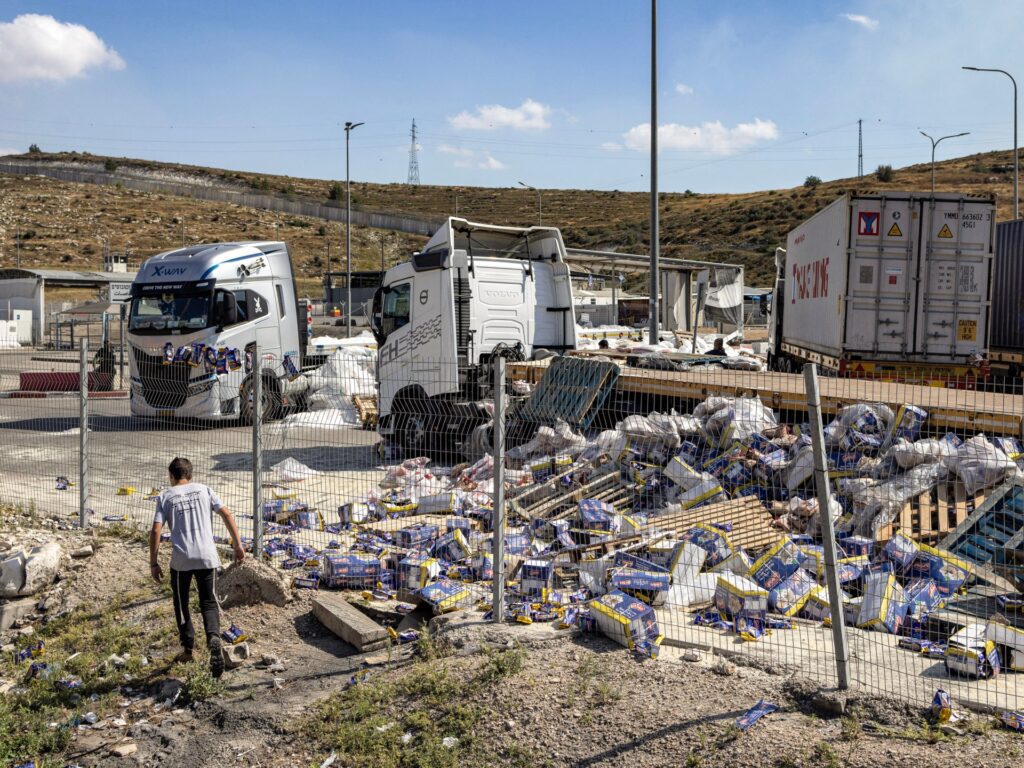A Washington Post report said that extremist settlers have intensified their attacks on aid trucks passing through the West Bank heading to the Gaza Strip.
Settlers have used a network of WhatsApp groups to track trucks and coordinate attacks on them, preventing food from reaching the Strip, while humanitarian organizations warn it is plunging deeper into famine.
The newspaper indicated that groups of young settlers are tracking relief convoys, setting up checkpoints and interrogating drivers.
In some cases, far-right Israeli attackers looted and burned trucks and beat Palestinian drivers, sending at least two to the hospital.
The attackers are using a network of WhatsApp groups to track trucks and coordinate attacks, as well as by taking advantage of what they say are tips from Israeli soldiers and police, as well as other Israeli residents.
Members of these groups scrutinize images to identify vehicles that might be carrying aid to Gaza and mobilize local supporters to stop them.
An attack last Thursday showed this system in action, as users in a WhatsApp group with more than 800 members began posting about a transport truck loaded with sugar, and sharing photos from the road as they followed it.
Youssef De Presser (23 years old) told his WhatsApp group, “The truck supplying Hamas stopped in front of Eviatar… Come and join the siege,” referring to an Israeli settlement site south of the city of Nablus in the occupied West Bank.
De Presser is one of the leaders of the “We Will Not Forget” movement, which set up protest camps at the Kerem Shalom crossing between Israel and Gaza earlier this year, and runs several WhatsApp groups targeting aid trucks.
Others responded to his request, and the truck was looted and its cargo was scattered along the road, according to photos that the group later published – one of two sugar trucks that the settlers vandalized that day.
De Presser said the bills of lading, which did not show the destination, proved that the truck was headed to Gaza, but the owner of the shipment, Fahd Arar, said the 30-ton load of sugar was actually headed to the city of Salfit in the West Bank.
Arar said the driver escaped unharmed, but the Israeli army did not allow him to reload the goods. Instead, soldiers removed the bags with a bulldozer and destroyed them. Arar estimated his losses at about $30,000.
For its part, the Israeli army said that forces arrived at the scene after the attack, dispersed civilians and “prevented further destruction.”
She denied that the soldiers prevented the driver from reloading the truck’s cargoHowever, a message in the settlers’ WhatsApp group stated that the police were the ones who removed the shipment.
The Washington Post says that acts of violence and vandalism, committed with almost complete impunity, raise questions about the readiness of the Israeli security forces to restrain extremist settlers and protect Palestinians.
It also challenges the Israeli government’s claim that it is doing everything it can to ensure the flow of aid to Gaza, where the humanitarian situation has deteriorated rapidly since the Israeli occupation forces’ incursion into the southern city of Rafah.
“We never called on people to take the law into their own hands,” said Rachel Tuito, spokeswoman for Tsav 9, which has hundreds of members, including settlers and demobilized reservists, and has been actively blocking aid trucks since January.
Although the group stopped its activities after the May 13 incident, Tweetow explained that the efforts will continue because it is in “the DNA of Tsav 9.” De Presser also said that he is “happy with every truck that does not enter Gaza, and I am also happy to see it catch fire.”
Some aid convoys coming from Jordan are now traveling under Israeli police guard. But other commercial trucks do not enjoy any security at all, including a soft drinks truck driven by Palestinian driver Ibrahim Al-Razem, who was heading to Kafr Aqab on the outskirts of Jerusalem when he collided with a roadblock on the night of May 16.
“They asked me if I was going to Gaza,” Razem, a Jerusalem resident, said of the crowd of settlers who stopped him. He said he presented documents to the group showing that the goods were destined elsewhere, but they were not satisfied, and asked him, “Are you Jewish or Arab?” And that’s right before they attack.
“They really wanted to kill me,” he added, stressing that the army officers at the scene did little to control the crowd. He said that he hid under an Israeli army vehicle to protect himself from strikes.
Razem, who suffered three fractures in the vertebrae, fractures in the ribs, and a fracture in the nose, confirmed, “If the army really wanted them to leave, they could have fired into the air.”
The truck, which he had decorated with mementos from his children, caught fire after he was taken to the hospital. He said, “This was my source of income… It was destroyed,” estimating his losses at about $200,000.

